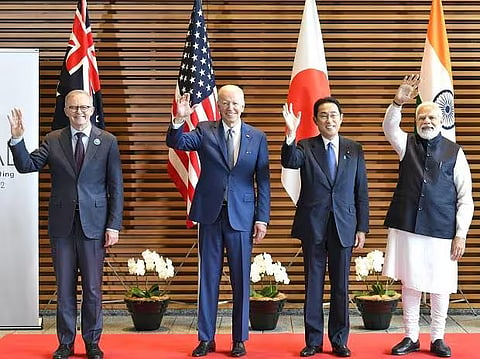

Shinzo Abe, the former Prime Minister of Japan, is often credited as a key figure in reviving and strengthening the Quadrilateral Security Dialogue, known as the QUAD. While it may be an oversimplification to call him the sole "father" of the QUAD, Abe played a significant role in its reformation and solidification.
The QUAD, initially formed in 2007, included the United States, Japan, Australia, and India, with the aim of promoting regional security and cooperation. However, the grouping faced challenges and was put on hold due to various geopolitical factors.
Shinzo Abe recognized the growing importance of a rules-based Indo-Pacific order and the need for increased strategic cooperation among like-minded nations. During his second term as Prime Minister from 2012 to 2020, Abe sought to revitalize the QUAD as a platform for promoting regional stability, maritime security, and freedom of navigation.
Abe actively pursued diplomatic initiatives to strengthen the QUAD and fostered closer ties with the member countries. He held discussions and bilateral meetings with leaders from the United States, Australia, and India to promote the QUAD's objectives and explore opportunities for cooperation.
Shared Values and Objectives
Abe's vision for the QUAD was based on shared democratic values, respect for international law, and a rules-based order. He emphasized the importance of upholding freedom of navigation and maintaining an open, inclusive, and stable Indo-Pacific region.
Abe's efforts included the establishment of a "Quadrilateral Security Dialogue" meeting at the senior official level in 2017, which was followed by ministerial-level meetings. These engagements helped to solidify the QUAD's foundation and demonstrate a shared commitment to regional security.
Future of the QUAD
The future of the QUAD looks promising, with the grouping gaining momentum in recent years. The QUAD has expanded its scope beyond security and maritime issues to include cooperation in areas such as infrastructure development, technology, and supply chain resilience.
The QUAD has also gained attention as a platform for addressing shared challenges, including the COVID-19 pandemic, climate change, and economic recovery. The member countries have initiated collaborative efforts in vaccine distribution, clean energy, and emerging technologies.
However, it is essential to note that the QUAD's future trajectory will depend on various factors, including the commitment of member countries, evolving regional dynamics, and the ability to effectively address common concerns. The QUAD's success will rely on maintaining the balance between cooperation and avoiding perceptions of it being an exclusive containment mechanism.
Conclusion
In recent years, the QUAD has received increased attention and support from member countries, indicating a growing recognition of the importance of a free and open Indo-Pacific region. As the QUAD evolves, its future will be shaped by the collective efforts of its members to foster stability, security, and prosperity in the region while engaging with like-minded partners.
While Shinzo Abe's role in reviving the QUAD was significant, it is essential to acknowledge the contributions and commitments of the other member countries as well. The QUAD represents a collective effort to strengthen regional cooperation and maintain a rules-based order in the Indo-Pacific.
